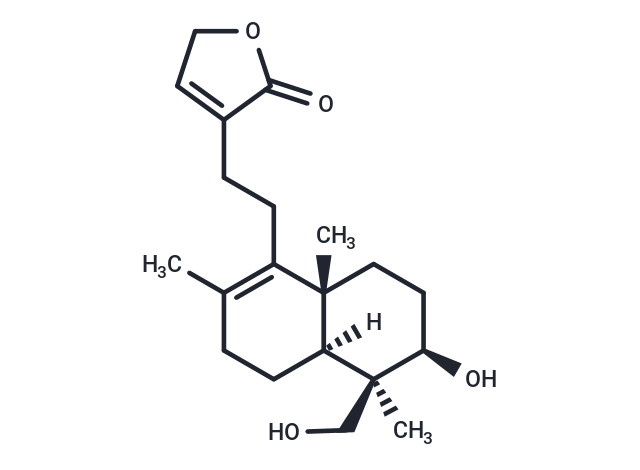Shopping Cart
- Remove All
 Your shopping cart is currently empty
Your shopping cart is currently empty

Deoxyandrographolide (14-deoxyandrographolide) potentiates NGF-induced neurite outgrowth. Deoxyandrographolide suppresses the production of proinflammatory mediators TNF-α and IL-6.

| Pack Size | Price | Availability | Quantity |
|---|---|---|---|
| 1 mg | $73 | In Stock | |
| 2 mg | $105 | In Stock | |
| 5 mg | $166 | In Stock | |
| 10 mg | $247 | In Stock | |
| 25 mg | $395 | In Stock | |
| 50 mg | Preferential | In Stock | |
| 1 mL x 10 mM (in DMSO) | $175 | In Stock |
| Description | Deoxyandrographolide (14-deoxyandrographolide) potentiates NGF-induced neurite outgrowth. Deoxyandrographolide suppresses the production of proinflammatory mediators TNF-α and IL-6. |
| In vitro | Treatment with 14-deoxyandrographolide (14-DAG) activated AMPK through induction of cyclic AMP-protein kinase A pathway [1]. 14-DAG down-regulated the formation of a death-inducing signaling complex, resulting in the desensitization of hepatocytes to TNF-alpha-induced apoptosis. Pretreatment of hepatocytes with 14-DAG accentuated microsomal Ca-ATPase activity through induction of NO/cGMP pathway [2]. 14-DAG, in concentrations between 10-100 μM, reduced the extracellular acidification rate and the intracellular alkalinization in a dose-dependent manner. In addition, 14-DAG reduced PAF-induced calcium flux in the presence of extracellular calcium, and tyrosine phosphorylation of a 44 kDa protein corresponding to the MAPK(ERK1) [3]. |
| In vivo | The protective effect of 14-DAG against ethanol-induced hepatic injury is based on its ability to reduce oxidative stress through cNOS dependent improvement of redox status. 14-DAG mediated activation of adenylate cyclase-cAMP signaling leading to the up-regulation of cNOS may provide a promising approach in the prevention of liver diseases during chronic alcoholism [4]. |
| Alias | 14-deoxyandrographolide |
| Molecular Weight | 334.45 |
| Formula | C20H30O4 |
| Cas No. | 79233-15-1 |
| Smiles | [H][C@]12CCC(C)=C(CCC3=CCOC3=O)[C@]1(C)CC[C@@H](O)[C@@]2(C)CO |
| Relative Density. | 1.123 g/cm3 (Predicted) |
| Storage | Powder: -20°C for 3 years | In solvent: -80°C for 1 year | Shipping with blue ice. | |||||||||||||||||||||||||
| Solubility Information | DMSO: 10 mg/mL (29.9 mM), Sonication is recommended. | |||||||||||||||||||||||||
Solution Preparation Table | ||||||||||||||||||||||||||
DMSO
| ||||||||||||||||||||||||||

Copyright © 2015-2025 TargetMol Chemicals Inc. All Rights Reserved.